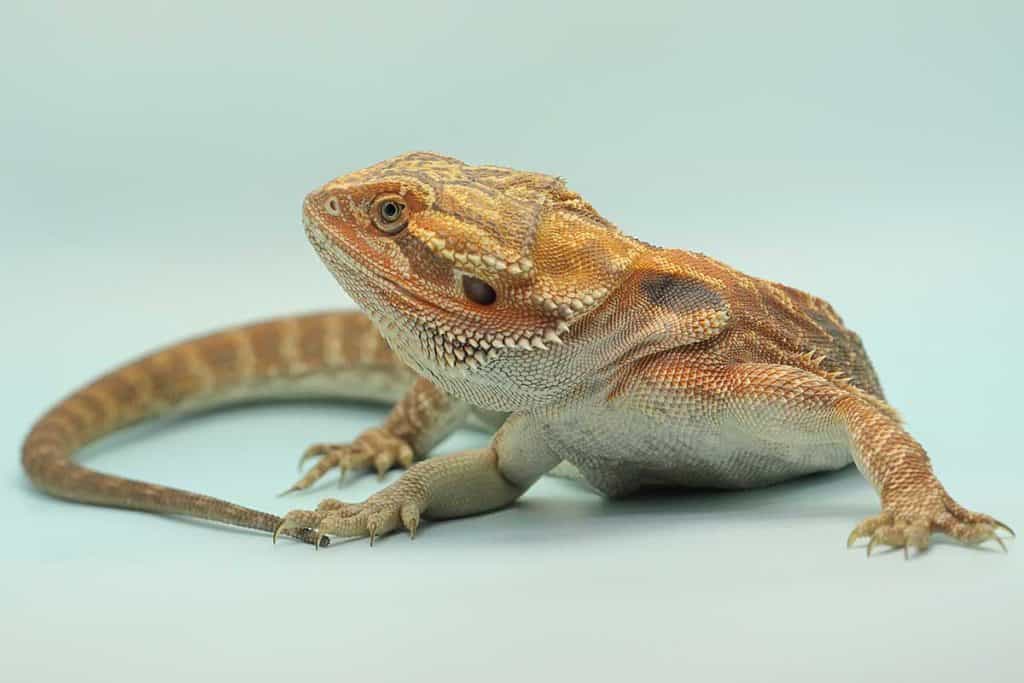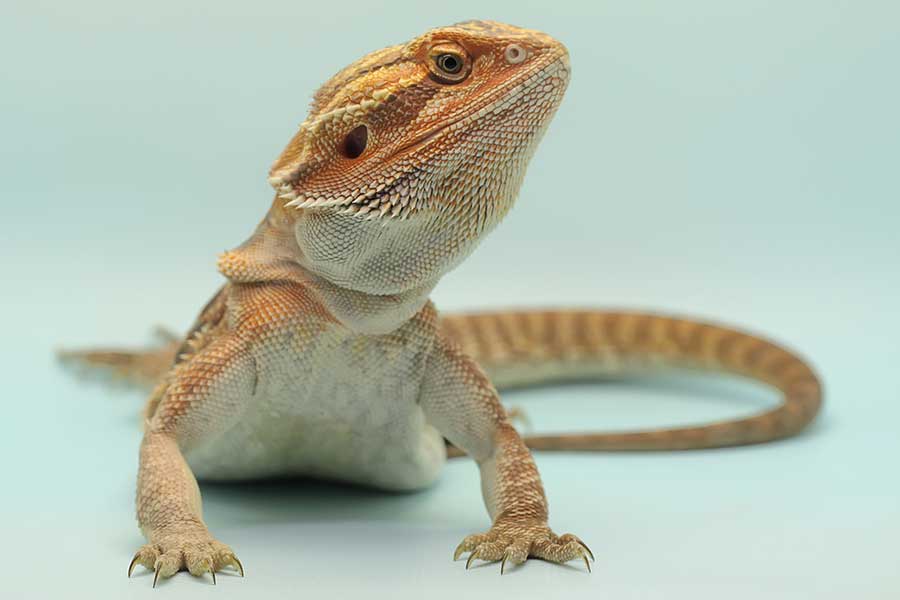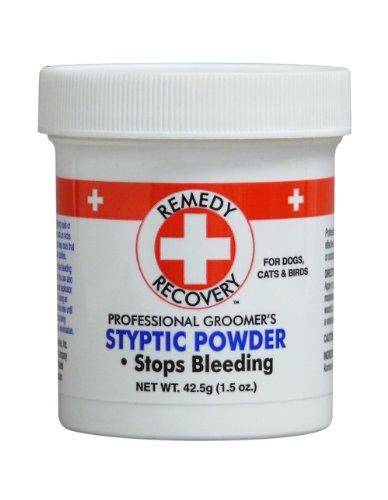If you’ve never trimmed your beardie’s nails and are wondering how that works, don’t worry! This guide will take you through the steps on how to trim bearded dragon nails.
Bearded dragons that live in captivity are limited in the amount of time they spend walking around on abrasive surfaces, so their nails are not properly worn down like those of wild bearded dragons. As their owner, this is where you need to step in.
Handling a bearded dragon with very sharp claws is unpleasant and can deter you from handling them frequently as well as cause you inadvertent harm. But it is not only for your safety that beardies need their claws cut! Bearded dragons with nails that are too long can be very uncomfortable and suffer terribly.
Read on to find out precisely why your beardie needs its nails cut, how often to cut your bearded dragon’s nails, as well as the precise steps on how to do it!
Why Do Bearded Dragons Need Their Nails Trimmed?
There are a number of reasons why pet bearded dragons need to have their nails trimmed. Let’s take a look at them below.
Wild Life Versus Captive Life
In the wild, bearded dragons are very active during the day and can travel long distances. They run over sand, rocks, and trees and dig deep burrows. All of these things have coarse, abrasive surfaces that help to wear down their nails.
However, in captivity, the amount of time spent running around on these textured surfaces is cut down considerably.
This means the natural process of wearing the nails down is also cut down. As a result, your bearded dragon’s nails will grow far too quickly without being worn down regularly, which is why you need to do it for them!
Maintaining Their Safety
Over time, very long nails will push your dragon’s toes up and to the sides. This twisting is painful and can cause lasting damage. This means when your bearded dragon wants to run around normally or perch on a branch or your shirt, it will not have the capacity to grasp properly with twisted toes and claws.
Occasionally, bearded dragons’ toenails can even get so long that they can begin to curl inwards and pierce their toes and feet. Bearded dragons’ nails often have bacteria on them, and this can lead to serious infections as well as being extraordinarily painful.
Apart from these cases being very painful for your bearded dragon, they are also a danger to them. Bearded dragons use their nails to hold onto and secure themselves to branches and other perches. If your bearded dragon cannot do this properly, then they run the risk of falling off and injuring themselves in another way.
Very long nails with sharp points also run the risk of getting caught in the substrate (especially reptile carpet that is not securely fitted) and on logs. If your bearded dragon gets a nail caught and pulls away, it can either break a toe or rip the nail out.
If a toe gets broken, it is very painful and can lead to other issues. If the nail gets ripped out, it will never grow back, and your bearded dragon will permanently lose some of its stability when grasping things.
Maintaining Your Safety
Your safety is also important when keeping your bearded dragon’s nails properly trimmed.
Small scratches or injuries on your skin caused by bearded dragon nails are a cause for concern. Bearded dragon nails, as I have mentioned, are the perfect breeding ground for bacteria and bacterial spores. This means that scratches from too-sharp nails can introduce harmful bacteria into your system, which can lead to infection and blood poisoning.
In addition to the harmful aspects too-sharp bearded dragon nails pose, they are also very uncomfortable and often painful whenever you want to handle your pet!
If it is too uncomfortable or painful to handle your bearded dragon apart from “functional” responsibilities like feeding, bathing, and enclosure cleaning, then they may become desocialized or even aggressive, which can lead to more serious problems in the future.
How Often to Cut Your Bearded Dragon’s Nails
On average, you should be trimming your bearded dragon’s nails about three to four times a year, or around once every season. However, this is not a hard and fast rule, as all bearded dragons grow at different rates and may have enclosures that help them or hinder them from wearing down their own nails.
There are two ways that you can judge when your bearded dragon needs to have its nails cut.
1. Evidence After Handling
Look at your arms and hands carefully after you have handled your bearded dragon. Do you see any pinpricks or scratches that were caused by your bearded dragon’s nails? If yes, then your bearded dragon is definitely due for a nail trim!
However, if you are not sure or want another test to see if they really need to be clipped, then try the second method of judging whether your bearded dragon needs its nails trimmed or not.
2. Watch Them Walk Around
Place your bearded dragon on a flat, hard surface like a table where you can get eye level with their feet. See if their nails are pushing their toes up over 90 degrees or forcing them to twist to the side.
If the nails are causing toe twisting, pushing the toes up at an odd angle, or digging into the skin, then it is time for a nail trim!
Tools Needed to Trim Your Bearded Dragon’s Nails
In addition to the tools mentioned below, you will need rubbing alcohol to sterilize your nail trimmer before using it and disinfect it after use.
Nail Trimmer
There is some debate in the reptile community about whether you need specialized tools or just a simple toenail cutter to do the job of cutting your bearded dragon’s nails.
I believe a pet nail trimmer is the best option. A small claw trimmer like this one from PetRepublique is ideal.
This PetRepublique nail trimmer has a circular cutting pattern that goes all the way around the nail and applies equal pressure to the whole area being cut. In contrast, human toenail trimmers apply force on only two points of the nail, which can cause it to split if the nail is damaged, weak, or too dry.
Styptic Product
You will also need styptic powder or a styptic pencil in the unfortunate incident you cut too far up and the nail starts to bleed.
Applying one of these products to a wounded nail (or any part of your bearded dragon after an unfortunate accident) will stop the bleeding almost instantly as well as seal the open wound to avoid bacteria from infiltrating the lizard’s blood system.
How to Cut a Bearded Dragon’s Nails
Cutting your bearded dragon’s nails is actually fairly easy and stress-free because it does not hurt, and if your bearded dragon is well-socialized and used to being handled, it will not be stressed out.
Here are some easy-to-follow steps on how to cut bearded dragon nails:
- Before you go and collect all the tools you’ll need, place a small (light) blanket over your bearded dragon’s head. This will simulate nighttime, and they should calm down and be nice and pliable.
- Now, collect your tools. Make sure everything you need is ready before you go and get your bearded dragon out of its enclosure.
- Keep a small bowl of water on hand in case you need to use the styptic pencil, as water activates it.
- Sterilize your trimming tool.
- Gently retrieve your bearded dragon from its enclosure. If it is too feisty, try again later.
- Place your bearded dragon on a table or your own body if they are calm enough. If they are not, ask a friend or family member to hold your bearded dragon gently so you can cut their nails.
- Identify what needs to be cut. The top of the nail is a smooth curve. However, the bottom has two parts to it. The tip is the point and has no blood vessels or nerves in it. As you move up the bottom of the nail, you will see or feel a small bump; this is where the quick is.
- Once you have identified where the point of the nail is and where the bump is, gently hold their toe in your fingers and clip off the point. It is a very small amount of material that you need to clip off.
- If you accidentally go too high and snip the quick, your beardie may react badly because this hurts. Quickly get some styptic product on it to control the bleeding.
- Once you are finished with all the nails, sterilize your tools again.
- It is always a good idea to give your beardie a treat right after nail trimming happens. A big juicy treat worm or a piece of fruit is ideal!
This process may sound terribly daunting when it is written out step by step. However, it is not too difficult when you actually need to do it! Spend some time getting to know your bearded dragon’s claw structure so you feel comfortable trimming their nails.
FAQs About Cutting Bearded Dragon Nails
Can I use a file instead of clippers?
Nail clippers are perfectly fine for bearded dragon nails. However, if you are lucky enough to have a bearded dragon that is cool, calm, and collected enough to have its nails filed…then go for it!
You can use an emery board or a Dremel to file down their nails. The same rules apply as the clippers, though. You need to file down to an appropriate length and look out for any nail splitting as well as have a designated file and rubbing alcohol to sanitize your tools afterward.
Clippers are the preferred method because you can get all four feet done relatively quickly and without causing too much stress for your bearded dragon. However, if your bearded dragon seems to enjoy having its nails filed, then this may be some excellent bonding time for you.
My bearded dragon hates getting its nails trimmed. How do I make it easier for them?
Your bearded dragon may not associate handling with anything but feeding or bathing, and so suddenly having their nails clipped may be a shock for them. The key to this is regular handling that has nothing to do with ‘function’ and is all about bonding with each other.
You can also try cutting your bearded dragon’s nails after bedtime. As they are diurnal reptiles, they will be sleepy and less likely to fight back or be freaked out by your handling them and trimming their nails.
Do I absolutely have to clip my bearded dragon’s nails?
For the most part, yes you do have to clip them at some point. Bearded dragons must have this grooming need met. However, if you are uncomfortable doing it, you can find a reptile groomer to do it for you or take your bearded dragon to the vet.
My bearded dragon’s nails are growing very fast, and I have to cut them every six weeks! What can I do to slow it down?
Your bearded dragon would naturally wear down their nails in the wild on things like rocks and branches. If they do not have access to these abrasive materials in their enclosure, then it may seem like their nails are growing too fast.
The remedy for this is simple. Place some large, flat rocks and possibly a digging box in your bearded dragon’s enclosure for them to wear down their nails. This does not mean you are off the hook for cutting them, though; it just means it should reduce the number of pedicures down to three to four times a year.
At the Tail End of Things…
Learning how to trim your bearded dragon’s nails will take some time as well as plenty of trial and error. However, with some patience and perseverance, you will succeed! Keeping your beardie calm, rewarding them with treats, and engaging in frequent ‘non-functional’ handling are all keys to success.
Cutting bearded dragon’s nails is a task that is integral to their care. All dragons are different, but in general, you’ll need to trim their nails at least three or four times per year to keep them healthy (and to keep you pain-free when handling them)!
Figure out the best way to trim your bearded dragon’s nails to keep them and yourself as calm as possible! Always cut with care, and pay close attention to your beardie’s behavior!





